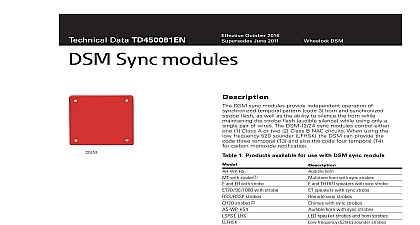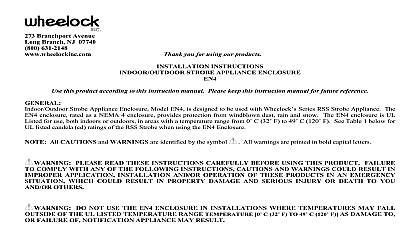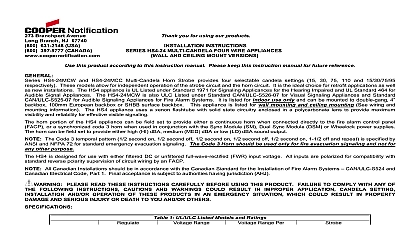Wheelock DSM sync module install sheet P83177

File Preview
Click below to download for free
Click below to download for free
File Data
| Name | wheelock-dsm-sync-module-install-sheet-p83177-0184635729.pdf |
|---|---|
| Type | |
| Size | 751.21 KB |
| Downloads |
Text Preview
INSTALLATION INSTRUCTIONS DSM SYNCHRONIZATION SYNC MODULE this product according to this instruction manual Please keep this instruction manual for future reference Cooper Notification Dual Sync Modules Series DSM are uniquely designed to accept two independent strobe and audible in and convert them to a single output that connects to the appliances listed in Table 1 When interfaced with the DSM the appliances the synchronized code 3 horn and synchronized strobe upon actuation The audible portion of the appliances can be controlled from the strobe using only a 2 wire alarm circuit DSMs are the ideal choice for alarm systems where an audible silencing is required during an alarm condition The DSM is designed for use with Class A or Class B wiring and are capable of synchroniz multiple alarm circuits if required The DSM can be used with 12VDC or 24VDC systems The DSM is UL Listed under Standard 1971 Appliances for the Hearing Impaired for indoor use Fire Protective Service and ULC Listed under CAN ULC S525 07 for Signal Devices for Fire Alarm Systems and CAN ULC S526 07 for Visual Signal Devices for Fire Alarm Systems All inputs are for compatibility with standard reverse polarity supervision of circuit wiring by a Fire Alarm Control Panel FACP THE DSM APPLIANCE IS A ALARM DEVICE DO NOT PAINT PLEASE READ THESE INSTRUCTIONS CAREFULLY FAILURE TO COMPLY WITH ANY OF THE FOLLOWING CAUTIONS AND WARNINGS COULD RESULT IN IMPROPER APPLICATION INSTALLATION AND OR OPERA OF THESE PRODUCTS IN AN EMERGENCY SITUATION WHICH COULD RESULT IN PROPERTY DAMAGE AND SERIOUS OR DEATH TO YOU AND OR OTHERS 1 Products Available for Use with DSM Sync Module AH WP HS MT with Strobe Horn Horn with Sync Strobes E and EH with Strobe and EH HIFI Speakers with Sync Strobe ET70 90 1080 with Strobe Speakers with Sync Strobe RSS RSSP Strobes Sync Strobes CH70 Strobes with Sync Strobes AS WP HS4 LSPST LHS LLFH Horn with Sync Strobes Speaker Strobes and Horn Strobes Frequency 520Hz Sounder Strobes Strobe portion of device is compatible audible portion does not synchronize All Canadian Installations should be in accordance with the Canadian Standard for the Installation of Fire Alarm Systems CAN and Canadian Electrical Code Part 1 Final acceptance is subject to Authorities Having Jurisdiction 2 Ratings Per UL and ULC Voltage Range Limit UL 1971 VDC 33.0 Range Per 33.0 THIS APPLIANCE WAS TESTED TO THE REGULATED VOLTAGE LIMITS OF 8.0 33.0 VOLTS USING FILTERED DC UNFILTERED FULL WAVE RECTIFIED FWR DO NOT APPLY VOLTAGE OUTSIDE OF THIS RANGE CHECK THE MINIMUM AND MAXIMUM OUTPUT OF THE POWER SUPPLY AND STANDBY BATTERY AND SUB THE VOLTAGE DROP FROM THE CIRCUIT WIRING RESISTANCE TO DETERMINE THE APPLIED VOLTAGE TO THE 3 UL ULC Current Ratings AMPS RMS Current Voltage MAKE SURE THAT THE TOTAL RMS CURRENT REQUIRED BY ALL APPLIANCES CONNECTED TO THE SYSTEM AND SECONDARY POWER SOURCES NAC CIRCUITS DSM SYNC MODULES OR COOPER NOTIFICATIONS POWER DO NOT EXCEED THE POWER SOURCES RATED CAPACITY OR THE CURRENT RATINGS OF ANY FUSES ON THE TO WHICH THESE APPLIANCES ARE WIRED OVERLOADING POWER SOURCES OR EXCEEDING FUSE RATINGS RESULT IN LOSS OF POWER AND FAILURE TO ALERT OCCUPANTS DURING AN EMERGENCY WHICH COULD RE IN PROPERTY DAMAGE AND SERIOUS INJURY OR DEATH TO YOU AND OR OTHERS calculating the total currents Use Table 3 to determine the highest value of Current for an individual strobe across the operating voltage range of the strobe then multiply these values by the total number of strobes be sure to add the currents any other appliances including audible signaling appliances powered by the same source and include any required safety factors INFORMATION Non sync appliances can be installed before or after a DSM If the Non Sync appliance requires audible silence four wire con is necessary with the strobe circuit connected before the DSM NAC circuit and the audible leads connected to a silenceable circuit from the FACP Power Supply may be used in conjunction with the DSM Sync Modules ONLY in the order shown in Figure 1 Only one Sync Module shall be allowed on a signaling circuit Do not connect the Power Supply to the signaling circuit after the one DSM Module Exception The Eaton Cooper Notification PS 6 PS8 Power Supply UL Only can be connected either before or after DSM Sync Module Refer to Power Supply instruction manuals for proper installation and application SYNC OR STROBE applications that require synchronizing multiple alarm circuits together daisy chain DSM as shown in Figure 2 using the sync then follow the wiring diagrams for specific applications Sync screw terminals can accept two 18 AWG wires for in out Strip leads 3 8 inches for connection to screw terminals 1 DSM Connection Diagram with Power Supply 1 2 SYNC MODULE SYNC MODULE SYNC MODULE LOOP MAXIMUM 2 Multiple Alarm Circuits Synchronization Up to 20 DSM The total length of wire connecting the DSM SYNC terminals should not exceed 1,000 feet of 18 American Wire Gauge overall between the first and last DSM If this limit is exceeded loss of synchronization between DSM may result The appliances draw power from strobe appliance circuit only Branchport Ave Long Branch N J 07740 800 631 2148 www coopernotification comPN P83177 ACCopyright 2014 Cooper Wheelock Inc dba Cooper Notificationfirealarmresources com single DSM unit can be used with one or two Class B signal circuits if using only one appliance circuit the DSM terminals for the appliance circuit should be left open B Wiring Diagram for the Sync Strobes Series LLFH 520Hz B WIRING B Wiring Diagrams for Series AS NS AH and NH Appliances SYNC MODULE Only LLFH appliances may be used in conjunction with the DSM in T3 T4 mode All appliances must be set to T3 T4 mode When using the LLFHS and LLFHN 520 Hz Low Frequency Sounder and Sounder Strobes in the T3 T4 mode connect a standard circuit to the and Audible Inputs on the DSM In the T3 T4 mode the DSM utilizes NAC 1 and or NAC 2 in conjunction with the Inputs to actively toggle between T3 fire and T4 CO as indicated in Table 4 OF LINE EOLR NEXT APPLIANCE EOLR NEXT APPLIANCE EOLR 3 Dual Class Circuit with Audible Silence Feature SIGNAL 1 SIGNAL 1 SIGNAL 2 OUT2 IN2 SYNC MODULE OUT2 IN2 1 2 OUT2 IN2 1 2 STROBE NEXT APPLIANCE EOLR NEXT APPLIANCE EOLR NEXT SYNC OR EOLR NEXT SYNC OR EOLR STROBE 5 Class Circuit Wiring for Sync Strobe and Black Shunt Wires are Supplied with DSM 4 Dual Class Circuit without Audible Silence Feature and Black Shunt Wires are Supplied with DSM B Wiring Diagram for Series RSS RSSP CH MT and Series E ET Sync Strobes SYNC MODULE 4 520 Hz Low frequency Sounder States for T3 T4 Mode Class B Wiring 1 Input 2 Input Hz Low Frequency Sounder State Input NAC Input Active Active Active Active Active Active for both NAC 1 and NAC 2 Active Active for both NAC 1 and NAC 2 Active Active Active for NAC 1 Active for NAC 1 Active for NAC 2 Active for NAC 2 Active or Not Active Active for both NAC 1 and NAC 2 For Class A Wiring only NAC 1 is Active or Not Active NAC 2 is used as the circuit return SYNC MODULE 1 1 1


